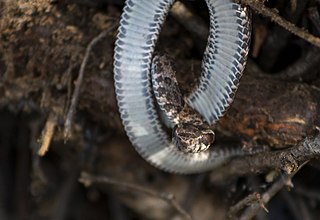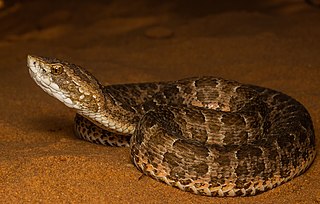
Belize is a country with a rich variety of wildlife, due to its unique position between North and South America, and a wide range of climates and habitats for plant and animal life. Belize's low human population, and approximately 8,867 square miles (22,970 km2) of undistributed land, provides an ideal home for more than 5000 species of plants, and vast numbers species of animals — with several hundred vertebrates including armadillos, snakes, and monkeys.

Ilha da Queimada Grande, more commonly referred to as Snake Island, is an island off the coast of Brazil in the Atlantic Ocean. The island became famous for its abundant snakes, hence the name "Snake Island." It is administered as part of the municipality of Itanhaém in the State of São Paulo. The island is small, with an area of only 43 hectares, and has a temperate climate. Its terrain varies from bare rock to rainforest.

The terciopelo is a species of pit vipers, found from north-east Mexico to northern South America. At low to moderate elevations, its habitat ranges from northeastern Mexico to Colombian and Ecuadorian Andes, as well as Venezuela. With a mass of up to 6 kilograms (13 lb), and a maximal length of 2.5 metres (8.2 ft), the terciopelo is among the largest vipers. It is light to dark brown in color, often with yellowish, zig-zag patterning on either side of its body. Dubbed "the ultimate pit-viper" for its defensiveness, large size, fangs and potent venom yield, it has a fearsome reputation, responsible for the most envenomated snakebites within its range, largely due to its proximity to humans, livestock and pets. Nonetheless, like all venomous snakes, the terciopelo actively avoids contact with humans and larger animals, with bites generally only occurring when the snake is cornered, pursued, or threatened. No subspecies are currently recognized.

Bothrops leucurus, commonly known as the whitetail lancehead or the Bahia lancehead, is a species of venomous snake, a pit viper in the family Viperidae. The species is endemic to Brazil. There are no subspecies which are recognized as being valid. A female owned by YouTuber Venom Central is over six feet long.

Bothrops insularis, commonly known as the golden lancehead, is a species of highly venomous pit viper in the subfamily Crotalinae of the family Viperidae. The species is found exclusively on the island of Ilha da Queimada Grande, off the coast of São Paulo state, in Brazil. The common name of the species refers to the light yellowish-brown color of its underside and for its lance-like head shape that is characteristic of the genus Bothrops. There are no subspecies of B. insularis that are recognized as being valid. It is one of the most venomous snakes in Latin America.
Bothrops pirajai, commonly known as Piraja's lancehead, is a species of venomous snake, a pit viper in the subfamily Crotalinae of the family Viperidae. The species is endemic to Brazil. There are no subspecies that are recognized as being valid.

Porthidium lansbergii is a species of venomous snake, a pit viper in the family Viperidae. The species is native to eastern Central America and northwestern South America. Four subspecies are recognized, including the nominate subspecies described here.

Bothrocophias campbelli, commonly known as Campbell's toadheaded viper, the Ecuadorian toadheaded pitviper, and víbora boca de sapo in Spanish, is a species of venomous pitviper in the family Viperidae. The species is endemic to South America. No subspecies are currently recognized.

Bothrops jararacussu, commonly known in English as the jararacussu, is a highly venomous pit viper species endemic to South America. It is one of the most dreaded snakes in South America and can grow up to 2.2 metres (7.2 ft).

Bothrops erythromelas, commonly known as the Caatinga lancehead or the jararaca-da-seca, is a species of venomous snake in the family Viperidae. It is endemic to Brazil.

Bothrops fonsecai, also known commonly as Fonseca's lancehead, is a species of venomous snake in the family Viperidae. The species is endemic to Brazil.

Bothrops lutzi, the Cerrado lancehead, is a species of venomous snake in the family Viperidae. The species is endemic to Central eastern Brazil. Within the country, it can be found in states such as: Minas Gerais, Bahia, Goiás, Tocantins, Piauí, and Ceará. The South American viper has sparked an interest from the scientific community due to its venom, as it is believed to have some therapeutic potential. Scientists have found that the venom carried by B. lutzi has antibacterial and antiparasitic effects, which can help fight against microbial resistance by medical patients, as well as parasitic diseases like leishmaniosis and Chagas’ disease.

Bothrops itapetiningae, or the São Paulo lancehead, is a species of venomous snake in the family Viperidae. It is endemic to the Cerrado region, savannas of central Brazil.

Bothrops jonathani, known commonly as Jonathan's lancehead or the Cochabamba lancehead, is a species of venomous snake, a pit viper in the family Viperidae. The species is endemic to South America.

Bothrocophias lojanus, also known commonly as the Lojan lancehead in English, and macanchi or macaucho in Spanish, is a species of venomous pit viper in the subfamily Crotalinae of the family Viperidae. The species is native to northwestern South America.
Bothrops marajoensis, or the Marajó lancehead, is a species of venomous snake in the family Viperidae. It is endemic to Brazil.

Bothrops moojeni, commonly known in English as the Brazilian lancehead, is a highly venomous species of snake in the family Viperidae. It is a pit viper endemic to South America.
Bothrops germanoi, also known as Moela's lancehead or jararaca-damoela is a species of pit viper from São Paulo, Brazil. It is named after Mr Valdir J. Germano, who is regarded as one of the most renowned Brazilian experts in snake identification.

Bothrops mattogrossensis, also known as Boca-de-Sapo, Jararaca, and Jararaca-Pintada in Portuguese, is a species of pit viper from Argentina, Bolivia, Brazil and Peru. As with all vipers, they are venomous. It has been mistaken for a subspecies of Bothrops neuweidi.
Bothrops sazimai, or Franceses Island-lancehead, is a species of pit viper from Franceses Island, Brazil.
2. Hartmann, Marília T., et al. “Feeding Habits and Habitat Use in Bothrops Pubescens (Viperidae, Crotalinae) from Southern Brazil.” Journal of Herpetology, vol. 39, no. 4, 2005, pp. 664–667. JSTOR, www.jstor.org/stable/4092860.
















